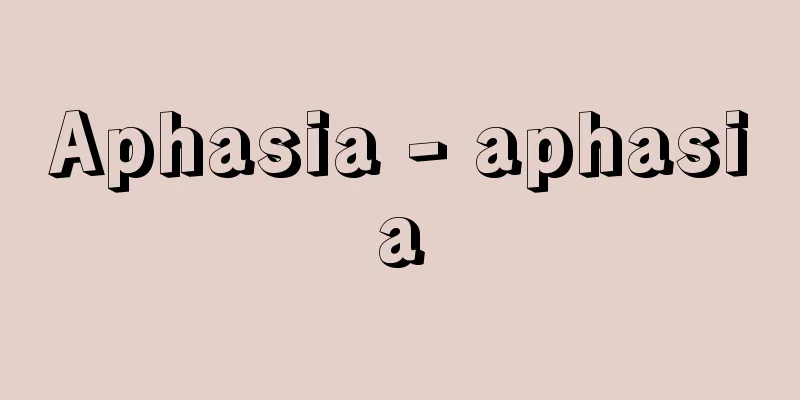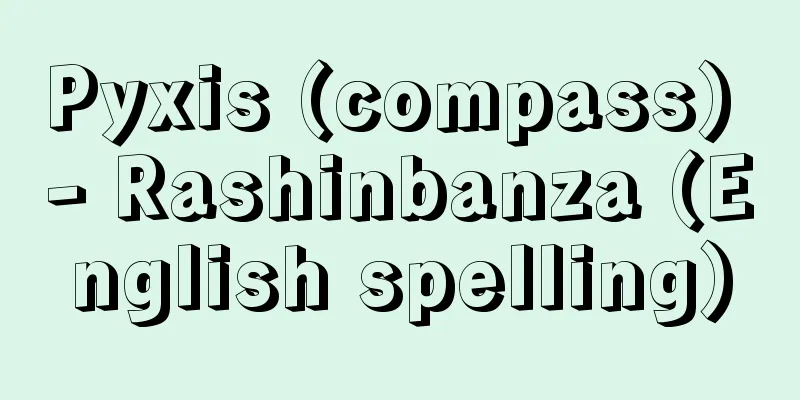Aphasia - aphasia

|
Aphasia refers to a condition in which a person cannot understand or express language due to damage to the language-related brain areas of the dominant hemisphere (the hemisphere responsible for language; in most people, the left hemisphere is dominant) even though there is no particular disorder of the ears, eyes, or articulatory organs. Language-related functions include functions related to sounds such as "listening" and "speaking" and functions related to letters such as "reading" and "writing." Aphasia is a condition in which these functions are impaired to a greater or lesser extent. Aphasia is different from speech disorders caused by paralysis of the articulatory organs or congenital structural abnormalities (dysarthria), peripheral deafness caused by disorders of the hearing organs, and aphonia, which is a psychogenic loss of voice. Aphasia is mainly caused by localized lesions in the language area due to cerebrovascular disorders such as cerebral hemorrhage and cerebral infarction, head trauma, brain tumors, encephalitis, etc. However, even if the language area itself is not damaged, aphasia can occur if there is a lesion in the putamen or thalamus (subcortical aphasia). Recently, aphasia caused by neurodegenerative diseases (Alzheimer's disease, frontotemporal lobar degeneration, corticobasal degeneration, etc.) that affect a wider area of the brain, including the language area, has also become well known. [Types of aphasia] Aphasia can be broadly divided into motor aphasia (nonfluent aphasia), where comprehension is relatively good but expression is poor (cannot speak smoothly), and sensory aphasia (fluent aphasia), where comprehension is poor and expression is problematic (can speak smoothly but make many mistakes and disorganize the conversation). According to the Wernicke-Lichtheim aphasia schema, which is the classical classification of aphasia, the pathway from hearing words (reception), to processing them in some way (concept), to speaking words (expression) is assumed to be as follows: subcortical auditory language center → auditory language center (Wernicke's center) → concept center → motor language center (Broca's center) → subcortical motor language center. Various clinical types of aphasia are easy to classify and understand when considering the location of damage according to this diagram, but it is also known that there are cases of aphasia that do not necessarily fit this diagram. Broca's aphasia is aphasia caused by damage to the posterior inferior frontal gyrus (Broca's area) of the dominant hemisphere, which impairs the motor speech center. However, if the damage is limited to the Broca's area, it is known that even if word amnesia (inability to properly recall words) is observed, Broca's aphasia does not occur. The lesions of Broca's aphasia often include the precentral gyrus and its anterior area, as well as the insula. In Broca's aphasia, speech volume is small and non-fluent, and speech is effortful and halting, with impairments in spontaneous speech, repetition, and reading aloud. On the other hand, auditory comprehension of language is relatively well preserved. Reading and writing is often better with kanji than with kana characters. Transcortical aphasia is a group of aphasias whose most notable feature is the retention of repetition (the ability to repeat words or sentences heard verbatim). Repetition is thought to be performed by the speech mechanism that runs from Wernicke's area through the arcuate fasciculus, Broca's area, and precentral gyrus, and if this speech mechanism is preserved, it is considered to be transcortical aphasia. Transcortical motor aphasia differs from Broca's aphasia in that repetition is preserved despite a decrease in speech production. Disorders in the pathway from the conceptual center to the motor speech center are assumed. The lesion is located in the medial part of the left frontal lobe (supplementary motor area, superior frontal gyrus) to the dorsolateral part (middle inferior frontal gyrus), but does not include the precentral gyrus. Subcortical motor aphasia is also called pure muteness. Because internal speech is preserved, it is difficult to express language by voice, but it is possible to express language by writing. Wernicke's aphasia is aphasia caused by damage to the cortical sensory center due to damage to the posterior superior temporal gyrus (Wernicke's area) of the dominant hemisphere. Although speech is fluent, the content is poor, there are many paraphasics (mistakes), and the meaning is unclear. New words (jargon) are also commonly seen. It is characterized by significant impairment of auditory comprehension of words, and repetition is also impaired. In the acute phase, patients are often talkative and have little awareness of the disorder. In Wernicke's aphasia, the lesion is rarely limited to Wernicke's area, and often spreads to surrounding areas such as the middle and lower temporal lobe and parietal lobe. In transcortical sensory aphasia, patients can recognize the sounds of words and can repeat them, but cannot understand the meaning of the words. Speech is fluent and there are many paraphasics. Subcortical sensory aphasia is also called pure word deafness. Because internal speech is preserved, auditory language comprehension is impaired, but visual language comprehension is normal. Amnesic aphasia is characterized by fluent speech and good auditory comprehension, but the inability to recall words (anonouns) or put them into words (word-finding difficulties). Indirect and roundabout explanations (circumlocutions) are often used. It is also called anomia. Conduction aphasia is characterized by relatively good speech comprehension and expression, but phonological (graphological) paraphasias (mispronouncing words such as "tokei" → "tekei") and reduced auditory retention (the ability to remember heard words for a short period of time, i.e. reduced linguistic short-term memory). Errors are particularly noticeable in repetition. Patients may realize their mistakes and self-correct (approach behavior), but because auditory retention is reduced, the words they should have spoken are often lost and they are unable to speak correctly. Global aphasia refers to a state in which all language-related functions are severely impaired due to widespread damage around the Sylvian fissure in the dominant hemisphere. Automatic speech of certain words (residual speech, reflexive speech) may be observed. In mixed transcortical aphasia, although the patient exhibits the appearance of global aphasia, repetition is preserved. However, this repetition is not accompanied by semantic comprehension, and the patient repeats exactly what he or she has heard, so echolalia (echoic speech) is prominent in the speech. Completion, in which the patient automatically repeats the rest of a proverb when the first letter of it is given, is also observed. Mixed transcortical aphasia is also called language area isolation syndrome because damage is observed that surrounds the language area. Crossed aphasia refers to aphasia caused by damage to the nondominant (right) hemisphere in a purely right-handed person. This is a rare case because the language areas of right-handed people are generally located almost entirely in the left hemisphere. [Testing methods for aphasia] To examine aphasia, spontaneous speech, repetition, reading aloud, naming ability, auditory comprehension, reading comprehension, spontaneous writing, dictation, and copying are tested in that order. In Japan, the standard language test of aphasia (SLTA), created in 1975 by the Aphasia Research Group (now the Japanese Society for Higher Brain Dysfunction) called the Nirayama Conference, is often used as a method to systematically test these. It consists of 26 subitems. The communicative abilities of daily living (CADL) test is a new test created in 1990. This test does not necessarily require verbal responses, but is a test to see whether interpersonal communication is maintained by verbal and non-verbal methods. WAB stands for Western Aphasia Battery, and the WAB aphasia test comprehensively tests language function and evaluates the presence and type of language symptoms. There are 38 test items under the eight main categories of spontaneous speech, comprehension of spoken language, repetition, naming, reading, writing, action, and composition. In the token test, auditory language comprehension and short-term memory are evaluated simultaneously using a combination of tokens with different shapes, sizes, and colors. → Apraxia → Agnosia → Cerebral hemisphere dominance [Masaru Mimura] Latest Sources Psychology Encyclopedia Latest Psychology Encyclopedia About Information |
|
失語とは耳や眼,あるいは構音器官に特別の障害がないにもかかわらず,優位半球dominant hemisphere(言語を担っている大脳半球,大多数の人は左半球が優位半球である)の言語と関連した脳領域の損傷のために,ことばを理解したり表現したりできない状態を指す。ことばと関連した機能としては,「聞く」「話す」といった音声にかかわる機能と「読む」「書く」といった文字にかかわる機能とがある。これらの機能が大なり小なり障害される症状を失語症という。失語症は,構音器官の麻痺や先天的な構造異常による発話の障害(構音障害dysarthria)や聴覚器官の障害による末梢性の聾deaf,あるいは心因性に声が出なくなる失声症aphoniaとは異なる。 失語症は主に脳出血,脳梗塞などの脳血管障害,頭部外傷,脳腫瘍,脳炎などによる言語野の局在病変が原因となる。しかし,言語野自体が損傷されていなくても,被殻や視床などに病変があると失語症を呈しうる(皮質下性失語)。最近では,言語野を含む脳のより広範な領域に病変が及ぶ神経変性疾患(アルツハイマー病や前頭側頭葉変性症,大脳皮質基底核変性症など)による失語症もよく知られている。 【失語の種類】 失語は大きく分けると,理解は比較的良いが表現がうまくいかない(スムーズに話せない)運動失語motor aphasia(非流暢型失語nonfluent aphasia)と,理解が悪く表現にも問題のある(スムーズに話せるが,言い間違いが多く会話がまとまらない)感覚失語sensory aphasia(流暢型失語fluent aphasia)とがある。失語症の古典的分類であるウェルニッケ-リヒトハイムWernicke-Lichitheimの失語図式によれば,ことばを聞いてから(受容),なんらかの処理を行ない(概念),さらにことばを話す(表出)に至るまでの経路として,皮質下聴覚言語中枢→聴覚言語中枢(ウェルニッケ中枢)→概念中枢→運動言語中枢(ブローカ中枢)→皮質下運動言語中枢という図式を想定する。臨床的な種々の失語類型はこの図式に従った損傷部位を考えると分類・理解しやすいが,必ずしもこの図式に当てはまらない失語症例があることも知られている。 ブローカ失語Broca's aphasia(皮質運動失語)は,優位半球の下前頭回後部(ブローカ野Broca's area)周辺の損傷により運動言語中枢が障害されることによる失語である。しかし,損傷がブローカ野に限局している場合は語健忘(ことばを適切に想起できないこと)を認めても,むしろブローカ失語にはならないことが知られている。ブローカ失語の病巣は中心前回とその前方領域,さらに島も含まれる場合が多い。ブローカ失語では発話量が少なく非流暢で,努力性でたどたどしい話し方となり,自発語・復唱・音読ともに障害される。一方,ことばの聴覚的理解面は比較的良好に保たれるのが特徴である。読み書きは,かな文字より漢字の方が良好なことが多い。超皮質性失語transcortical aphasiaとは,一般に復唱(聞いたことばや文章をそのまま繰り返すこと)が保たれていることを最大の特徴とする失語群である。復唱はウェルニッケ野Wernicke's areaから弓状束,ブローカ野,中心前回を経由する発話機構で営まれていると考えられており,この発話機構が保存されていれば超皮質性失語となると考えられている。このうち超皮質性運動失語はブローカ失語とは異なり,発語が減少しているにもかかわらず,復唱は保たれているのが特徴である。概念中枢→運動言語中枢の経路の障害が想定されている。病巣としては左前頭葉の内側部(補足運動野,上前頭回)から背外側部(中下前頭回)であるが,中心前回は含まれない。皮質下運動失語は純粋語啞ともよばれる。内言語は保たれているため,音声による言語表出は困難であるが,書字による言語表出は可能である。 ウェルニッケ失語Wernicke's aphasia(皮質感覚失語)は優位半球の上側頭回後部(ウェルニッケ野)周辺の損傷により,皮質感覚中枢が障害されることによる失語である。発話は流暢だが,発話のわりに内容には乏しく,錯語(言い間違い)が多く,意味不明である。新造語(ジャーゴン)もよく見られる。ことばの聴覚的理解が著しく障害されるのが特徴で,復唱も障害される。急性期ではしばしば多弁であり,障害の自覚に乏しい。ウェルニッケ失語も病巣がウェルニッケ野に限局していることはまれであり,側頭葉中下部や頭頂葉などの周辺領域に広がっている場合が多い。超皮質性感覚失語は,ことばの音を認知することができ,復唱もできるが,ことばの意味が理解できない。発話は流暢で,錯語が多い。皮質下感覚失語は純粋語聾ともよばれる。内言語が保たれているため,聴覚による言語理解は障害されているが,視覚入力による言語理解は正常に保たれている。 健忘失語amnesic aphasiaは発話が流暢で聴覚的理解も良好であるが,ことばが思い出せない(失名詞),ことばにできない(喚語困難)ことが特徴である。遠まわしで回りくどい説明(迂言)がしばしば見られる。失名詞失語anomiaともよばれる。伝導失語conduction aphasiaはことばの理解も表出も比較的良好だが,音韻性(字性)錯語(「とけい」→「てけい」のようにことばの音を間違える)と聴覚的把持の低下(聞いたことばを短期間覚えておく力,すなわち言語性短期記憶の低下)を特徴とする。とくに復唱で誤りが目立つことが特徴である。自らの誤りに気づき自己修正を行なう(接近行為)が,聴覚的把持が低下しているため,発語すべきことばが失われ,正しい発語に至らないことが多い。 全失語global aphasiaは優位半球シルビウス裂周囲の広範な損傷により,言語に関連したすべての言語機能が重篤に障害されている状態を指す。特定のことばの自動的発話(残語,再帰性発話)が見られることもある。混合型超皮質性失語においては,全失語の様相を呈するものの,復唱だけは保たれている。しかし,その復唱は意味理解を伴っておらず,聞いたことばをそのまま復唱するため,発語は反響言語(オウム返し)が目立つ。ことわざなどの初め一文字を与えると,その続きを自動的に言う補完現象も見られる。混合型超皮質性失語では言語野を取り囲むような損傷を認めるため,言語野孤立症候群ともよばれる。 交叉性失語crossed aphasiaとは,純粋な右利きの人が非優位(右)半球の損傷により失語を呈した場合を指す。一般に,右利き者の言語野はほぼ左半球に存在するため,まれな症例である。 【失語症の検査法】 失語症を調べるには,自発言語・復唱・音読・呼称能力・聴覚的理解・読解・自発書字・書き取り・写字を順に検査していく。これらを系統的に検査する方法として,日本では1975年に韮山カンファレンスとよばれた失語症研究会(現,日本高次脳機能障害学会)が作成した標準失語症検査standard language test of aphasia(SLTA)がよく用いられる。26の下位項目より成る。実用コミュニケーション能力検査communicative abilities of daily living(CADL)は1990年に作られたまだ新しい検査である。この検査は必ずしもことばでの回答を求めておらず,言語的・非言語的手法により対人コミュニケーションが保たれているかを見る検査である。WABはwestern aphasia batteryの略であるが,WAB失語症検査では,言語機能を総合的に検査して,言語症状の有無やタイプなどについて評価する。自発話,話しことばの理解,復唱,呼称,読み,書字,行為,構成の八つの主項目のもとに38の検査項目がある。トークンテストでは,形,大きさ,色の異なるトークンの組み合わせで,聴覚的言語理解と短期記憶の二つを同時に評価する。 →失行 →失認 →大脳半球優位性 〔三村 將〕 出典 最新 心理学事典最新 心理学事典について 情報 |
>>: Jikkoku Pass - Jikkoku Pass
Recommend
Questions and Answers on Customs and Customs
This was a survey of the manners and customs of ea...
Moncenisio
…The Alps are steep on the Piedmont side, but the...
Appalachian relief
…The alternation of hard sandstone layers and sof...
Murakami Namiroku - Murakami Minamiroku
Novelist. Born in Sakai, Osaka. Real name Makoto....
Water moccasin (English spelling)
...It is found in Taiwan, southern China, and Ind...
MacDonald, DB (English)
...In the early 18th century, the French oriental...
slump
...Some contain a large amount of water, while ot...
National Advisory Committee for Aeronautics
...One of the US government agencies responsible ...
cowbird
...In the oropendola and cacique species, the bas...
X-ray photoelectron spectroscopy
...The method that uses light irradiation is call...
Herrmann, JW
…Schleiermacher, along with Pietism, criticized d...
Iris japonica - Iris japonica
...The inflorescence is slightly upward-slanting,...
Kikyo water - Kikyo water
For example, the terms "upstream" (west...
Seneca
...the Iroquois were Indians who lived in the for...
Hisamatsu-shi
Lord of Matsuyama Domain, Iyo Province. During th...







![Futami [town] - Futami](/upload/images/67ccb5f9e4dbb.webp)

